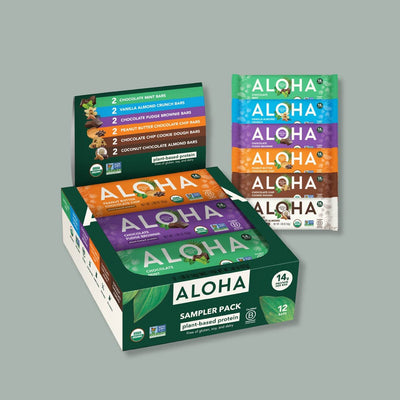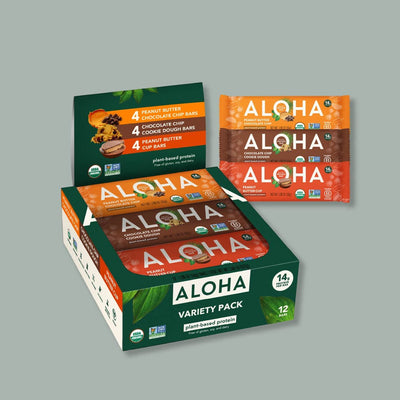Key Takeaways:
- Taro Has a Unique Yet Versatile Flavor: Taro’s taste is a mix of mild sweetness, nuttiness, and a subtle earthiness. Its adaptable nature makes it ideal for both sweet and savory dishes.
- Cooking Enhances Taro’s Natural Taste: Raw taro can be bitter and irritating, but cooking transforms it into a smooth, mildly sweet ingredient. Different cooking methods affect its texture and depth of flavor.
- Taro Works Well in a Variety of Foods: From bubble tea to savory curries, taro can be enjoyed in countless ways. Its ability to blend with flavors makes it a favorite in many global cuisines.
Can you imagine a root vegetable that tastes slightly sweet, nutty, and creamy all at once? Taro is one of those rare ingredients that surprises first-time eaters with its unique yet comforting flavor.
At ALOHA, we’re passionate about bringing nature’s most wholesome and delicious foods to your table. As advocates for organic, non-GMO, and plant-based nutrition, we love introducing ingredients like taro that offer great taste and versatility.
In this piece, we’ll explore the distinct flavor of taro, how it changes when cooked, and the best ways to enjoy it. If you’ve been curious about trying taro, this guide will help you understand why it’s becoming a favorite among food lovers.
What Does Taro Taste Like?
Taro has a mild, subtly sweet flavor with a hint of nuttiness, making it a versatile ingredient in sweet and savory dishes. Its taste is often compared to a blend of sweet potato and chestnut, and its creamy texture becomes even smoother when cooked.
Raw taro, however, is not meant to be eaten due to its naturally occurring calcium oxalate crystals, which can irritate. Once cooked, it takes on a starchy, almost buttery consistency with a delicate earthiness that pairs well with various flavors. Some describe its taste as a mellow, more refined version of a potato with a touch of natural sweetness.
Taro’s Unique Flavor Compared To Other Foods
Taro’s flavor is often described as familiar and unique, making it difficult to compare directly to just one ingredient. It has a delicate balance of sweetness, nuttiness, and starchiness, allowing it to work well in sweet and savory dishes. To better understand its taste, let’s compare it to some well-known foods:
Taro Vs. Sweet Potato: A Gentle Sweetness
Taro shares a mild sweetness similar to sweet potatoes but with a more subtle and refined profile. While sweet potatoes can sometimes be intensely sugary, taro’s natural sweetness is more delicate, making it a great ingredient for dishes that don’t require an overpowering flavor. This slight sweetness allows taro to blend effortlessly into creamy soups, porridges, and desserts without overwhelming the dish.
Taro Vs. Chestnuts: A Nutty Depth
Another common comparison is chestnuts, as taro carries a faint nuttiness that gives it depth. Chestnuts have a naturally earthy and slightly sweet taste, which mirrors taro’s flavor when cooked. This nutty undertone makes taro an excellent base for rich, hearty dishes like stews, curries, and baked goods.
Taro Vs. Potatoes: A Creamy Texture
When it comes to texture, taro is often compared to potatoes, but it has a softer, creamier consistency when cooked. Unlike regular potatoes, which can be grainy or fluffy depending on the variety, taro tends to be smoother, making it perfect for mashed preparations and thickening soups. This creaminess is a favorite ingredient in milk-based beverages like taro bubble tea.
Taro’s Vanilla-Like Aroma In Sweet Dishes
One of the most unique aspects of taro is its faint vanilla-like aroma, which sets it apart from other starchy vegetables. This natural fragrance is why taro is often used in desserts, where it enhances flavors without the need for artificial additives. This subtle aroma in dishes like taro pudding, ice cream, and cakes creates an almost floral sweetness that makes each bite more enjoyable.
Taro’s Earthy Notes In Savory Dishes
In contrast to its sweet applications, taro’s mild earthiness makes it an excellent addition to savory meals. When paired with coconut milk, garlic, or spices, taro has a rich, well-rounded taste that enhances the dish’s depth. Its ability to absorb flavors while maintaining its signature nuttiness makes it a staple in Asian and Pacific Islander cuisines.
Does The Taste Of Taro Change When Cooked?
Taro’s raw flavor and texture differ from its cooked form, making preparation essential to enjoy its taste fully. When uncooked, taro contains calcium oxalate crystals, which can cause irritation, making it unsafe to eat. However, once properly cooked, taro transforms into a smooth, creamy, and slightly sweet ingredient that enhances both sweet and savory dishes:
Raw Taro: Bitter And Irritating
Due to its naturally occurring toxins, taro is not meant for direct consumption in its raw state. Calcium oxalate crystals give it a sharp, tingling sensation that can cause discomfort in the mouth and throat. This bitter, starchy taste disappears completely once taro is thoroughly boiled, steamed, or roasted.
Boiled Or Steamed Taro: Soft And Mildly Sweet
Boiling or steaming taro is the most common cooking method, as it softens the root and enhances its natural sweetness. The process removes its bitter elements, leaving behind a mild, nutty, and slightly sweet flavor that is perfect for soups, curries, and side dishes. Its texture resembles a smooth potato but with a richer, silkier consistency.
Fried Taro: Crispy Outside, Soft Inside
When fried, taro develops a crispy outer layer while maintaining its creamy interior, much like French fries or tempura. This method intensifies its natural sweetness, making it a delicious snack or side dish. Fried taro chips, in particular, have a subtly sweet and nutty crunch that rivals traditional potato chips.
Roasted Taro: Deep And Earthy
Roasting taro brings out its rich, earthy flavors and enhances its nutty undertones. The slow cooking process caramelizes some of its natural sugars, giving it a slightly sweeter and more complex taste. Roasted taro pairs well with spices and herbs, making it a flavorful alternative to roasted potatoes or yams.
Blended Taro: Creamy And Velvety
Blending cooked taro into smoothies, soups, or desserts creates a thick, velvety consistency with a mild, sweet taste. This method is popular in bubble tea, where taro’s natural creaminess adds a luscious texture without artificial thickeners. When mixed with coconut milk or dairy, it further enhances its rich, dessert-like quality.
Popular Dishes That Highlight Taro’s Flavor
Taro’s mild sweetness, nutty undertones, and creamy texture make it a key ingredient in cuisines worldwide. This versatile root enhances flavor and texture, whether incorporated into savory dishes or indulgent treats like protein bars. Here are some of the most popular ways taro is used across different culinary traditions:
Taro Bubble Tea: A Creamy And Sweet Delight
Taro bubble tea is one of the most well-known ways to enjoy this root. It offers a rich, velvety texture with a naturally sweet, nutty flavor. Blended with milk or coconut milk, this drink creates a smooth, dessert-like experience, often paired with chewy tapioca pearls for extra indulgence. The light vanilla aroma of taro makes it a favorite among bubble tea lovers who enjoy creamy, naturally sweet beverages.
Taro Chips: A Crunchy And Nutritious Snack
Thinly sliced, fried, or baked taro chips are a healthier alternative to traditional potato chips. They have a satisfying crunch with a slightly nutty sweetness, making them a delicious standalone snack or a flavorful addition to dips. Unlike regular chips, taro chips retain a hearty, earthy depth that elevates their taste beyond just salty and crispy.
Taro Cake: A Savory Dim Sum Favorite
Taro cake is a staple in Chinese cuisine, particularly as a dim sum dish. Made with mashed taro, rice flour, and seasonings, it is steamed until firm and then pan-fried to develop a crispy golden crust. The combination of creamy taro inside and a crisp exterior makes it a delicious balance of textures and flavors. It is often served with soy sauce or chili oil for extra taste.
Taro Ice Cream: Naturally Sweet And Nutty
Taro ice cream highlights the root’s natural sweetness while delivering a creamy consistency. Its subtle nutty notes give it a depth of flavor that sets it apart from traditional vanilla or chocolate ice creams. Many artisanal ice cream shops now feature taro as a specialty flavor due to its unique taste and striking purple hue.
Taro In Curries And Soups: A Hearty, Starchy Addition
In Southeast Asian and Pacific Islander cuisines, taro is often added to curries, stews, and soups for its rich, starchy texture. It absorbs flavors beautifully, blending seamlessly with coconut milk, garlic, and spices to create a comforting, well-rounded dish. Whether used in a spicy Thai curry or a Hawaiian luau stew, taro enhances the dish’s depth while adding a smooth, creamy consistency.
Final Thoughts
Taro isn’t just a flavorful ingredient—it’s a testament to how nature offers nourishment and indulgence. Its subtly sweet, nutty taste and creamy texture make it a favorite in traditional and modern cuisine, proving its versatility across cultures. More than a trendy ingredient, taro carries deep-rooted culinary significance that makes it worth exploring. Whether you’re new to taro or a longtime fan, its unique flavor profile invites curiosity and creativity in the kitchen.
Read also:
- Protein For Vegetarians: Steps To Meet Daily Protein Needs
- How Many Protein Shakes A Day? Guide For Optimal Intake
- Benefits Of Superfoods: Why They Boost Your Health
Frequently Asked Questions About What Does Taro Taste Like
Is taro naturally sweet, or does it need added sugar?
Taro has a mild natural sweetness but is not as sugary as fruits or sweet potatoes. Many dishes enhance its sweetness by adding coconut milk, sugar, or honey. Its subtle flavor allows it to work well in both naturally sweet and savory recipes.
Does taro taste the same in every region?
The taste of taro can vary slightly depending on where it is grown and how it is prepared. Different soil conditions and climates can affect its sweetness and nuttiness. Additionally, cooking methods and seasoning choices influence how taro’s natural flavor is perceived.
What kind of aftertaste does taro leave?
Taro has a slightly starchy aftertaste with a mild nutty or earthy note that lingers on the palate. It can leave a creamy, almost vanilla-like finish when used in sweet dishes. It absorbs spices well in savory dishes and leaves a comforting, hearty taste.
Does taro taste good with dairy products?
Yes, taro pairs exceptionally well with dairy or dairy alternatives like coconut, almond, and oat milk. Its natural creaminess complements the richness of milk-based products. This is why taro is commonly used in milk teas, creamy soups, and desserts.
Can taro taste bitter?
Raw taro has a slightly bitter and astringent taste due to naturally occurring calcium oxalate crystals. Once properly cooked, the bitterness disappears, leaving a smooth, mildly sweet flavor. Undercooking taro may cause a lingering bitterness, so it should always be fully cooked.
What is the closest vegetable to taro in terms of taste?
Taro’s taste is most closely related to a combination of sweet potatoes and chestnuts. It has the mild sweetness of a sweet potato but with a softer, nuttier flavor. Unlike potatoes, taro has a silkier texture when cooked, making it unique among root vegetables.
How does taro taste in drinks compared to solid foods?
In drinks like bubble tea or smoothies, taro has a creamy, slightly sweet, and nutty taste, similar to vanilla, with an earthy undertone. When eaten in solid form, the starchiness is more noticeable, and the nuttiness is stronger. The consistency in beverages makes them taste smoother and more dessert-like.
Does taro have a strong flavor, or is it mild?
Taro has a mild flavor that easily absorbs the taste of other ingredients. It’s not overpowering, which is why it is commonly used as a base in many dishes. Its ability to take on different flavors makes it popular in sweet and savory recipes.
Can you taste the difference between fresh taro and processed taro products?
Yes, fresh taro has a more pronounced nutty and earthy taste compared to processed taro powders or extracts. Processed taro products, often used in instant taro drinks or desserts, may contain added sugar and artificial flavoring. While both are enjoyable, fresh taro offers a more authentic and complex flavor.
Does the way taro is sliced or prepared affect its taste?
The way taro is prepared can influence its taste and texture. Thin slices fried into chips develop a richer, roasted flavor, while mashed or blended taro creates a smoother, creamier experience. Cooking techniques like steaming or roasting can enhance its natural sweetness and nuttiness.
Sources:
1. Zi, H., Chen, R., Jia, N., Ma, Y., Zhao, C., Chen, Z., & Zhang, J. (2024). Impact of Cooking Duration on Calcium Oxalate Needle-like Crystals in Plants: A Case Study of Vegetable Taro Flowers in Yunnan. Foods, 13(23), 3730–3730. https://doi.org/10.3390/foods13233730
2. Salgado, N. C., Mafalda Alexandra Silva, Maria Eduardo Figueira, Costa, H. S., & Albuquerque, T. G. (2023). Oxalate in Foods: Extraction Conditions, Analytical Methods, Occurrence, and Health Implications. Foods, 12(17), 3201–3201. https://doi.org/10.3390/foods12173201
3. Ferdaus, M. J., Chukwu-Munsen, E., Foguel, A., & da Silva, R. C. (2023). Taro Roots: An Underexploited Root Crop. Nutrients, 15(15), 3337. https://doi.org/10.3390/nu15153337
ALOHA's products are not intended to treat, diagnose, mitigate, prevent, or cure disease. ALOHA's products should not replace prescribed medications or the variety of foods important to a healthful diet.
Do not self-diagnose any health condition. Work with your healthcare provider to determine how best to achieve optimal health.












